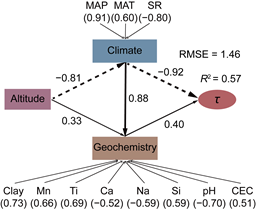The alpine grasslands of Qinghai-Tibet Plateau play an important role in the ecological carbon sink, and the turnover times (τ) of soil organic carbon (SOC) can effectively characterize the stability of SOC, which is a key parameter to predict the change of soil carbon pool. In order to comprehensively assess SOC turnover times under typical land-use patterns on the Tibetan Plateau and reveal the driving mechanism of SOC turnover in alpine grasslands, the “Land Use Change and its Environmental Effects” research team estimated the turnover time (0-30 cm) of soil organic carbon in 169 grassland samples along the 3000 km transboundary of the Tibetan Plateau through continuous field sampling survey. The key factors affecting SOC τ in the study area were analyzed by combining climatic variables (such as annual mean precipitation (MAP) and annual mean temperature (MAT)) and geochemical variables (such as soil total element content (Mn, Ti, Fe, Si, Al, Mg, Ca, Na, K, and P), soil clay content and pH). The research results provide a scientific basis for the response of alpine grassland organic carbon to climate change under the influence of human activities, in order to facilitate the realization of the national carbon neutrality goal.

Figure 1. (a)Spatial distribution of sampling points and (b) turnover times of soil organic carbon in the Alpine grasslands of Qinghai-Tibet Plateau
The results showed that :(1) the alpine grassland τ ranges from 4 to 289 years, decreasing from northwest to southeast, and increasing with the elevation (FIG. 1). The τ of the alpine meadow was 7178 63 years (mean and 95% confidence interval), with no significant difference from that of alpine grassland (7687 65 years). (2) Based on the enhanced regression tree analysis, geochemical variables are the most important controlling factors of τ (54%), followed by climate (36%) and altitude (10%). Precipitation was the main predictor of τ, followed by soil Si content and altitude (FIG. 2). (3) Altitude indirectly affects τ by adjusting climate and soil geochemical conditions, and the direct effect of climate on τ is opposite to its indirect effect (FIG. 3). These results emphasize the importance of geochemical factors in assessing the response of soil organic carbon turnover to climate change. This study named “Climate and geochemistry interactions at different altitudes influences soil organic carbon turnover times in alpine grasslands” has been published in Agriculture, Ecosystems and Environment. Professor Wang Xia is the corresponding author, and PhD candidate Zhao Yunfei is the first author. This work was supported by the Second Qinghai-Tibet Plateau Scientific Expedition and Research Program (2019QZKK0603) and the General Project of the National Natural Science Foundation of China (41971051).


Figure 2 Relative contribution of predicted variables to turnover time of organic carbon
Figure 3 Path analysis of the turnover time of soil organic carbon
The article information: Xia Wang*, Zhao Yunfei, Jiang Silong, Zhou Xiaohe, Liu Huiying, Xiao Jinjin, Hao Zhiguo, Wang Kaichang. (2021). Climate and geochemistry interactions at different altitudes influence soil organic carbon turnover times in alpine grasslands. Agriculture, Ecosystems and Environment 320 (2021) 107591.
Article link: https://doi.org/10.1016/j.agee.2021.107591